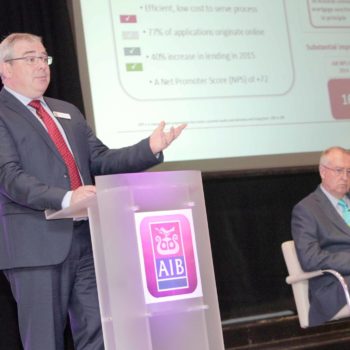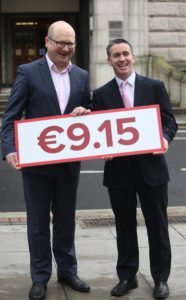Banks still in a fragile condition

Dan White examines the health of Ireland's banking system and looks at the growing gap between Irish and British minimum wages
19 August 2016
The dismal stress test results and the very high non-performing loans revealed in their first-half results demonstrate that, eight years on from the bust, the Irish banks remain in a very fragile condition.
On 29 July the European Banking Authority published the results of its latest stress tests of EU banks. These showed that the two main Irish banks, AIB and Bank of Ireland, were among the worst-placed of any European banks to weather a prolonged economic downturn.
A positive spin
Both of the Irish banks rushed out statements seeking to put their stress test results in the best possible light.
AIB told shareholders that the stress test was based on its end-2015 balance sheet and “does not reflect current or future improved financial performance”. The word from Bank of Ireland was “the group’s capital position is strong and the group continues to organically generate capital”.
Nothing going on here, now please move along folks!
Despite the soothing words, the stress test results highlight once again that, eight years after the death of the Celtic Tiger, the Irish banks are still in a very weak state.
Non-performing loans
Coincidentally both AIB and Bank of Ireland published their results for the six months to the end of June virtually simultaneously with the stress test results.
These showed that AIB still has €11.3bn of non-performing loans on its balance sheet, almost 17% of its total loan book, while Bank of Ireland has €9.9bn of non-performing loans, 12.3% of its the total loans.
While the half-year results showed that both AIB and Bank of Ireland were profitable in the first six months of 2016 with AIB recording a pre-tax profit from continuing operations of just over €1bn and Bank of Ireland €557m, the AIB figure was only achieved after the write-back of €214m of previous provisions against bad loans.
With such high levels of non-performing loans, both of the main Irish banks are continuing to shrink their loan books with the AIB loan book having been reduced by a further €3.1bn to €67bn in the first six months of 2016 while the Bank of Ireland loan book was down by a further €5bn to €80bn over the same period.
Convalescent stage of recovery
As the two major banks go, so does the rest of the Irish banking system. The most recent Central Bank figures show that lending to households and non-financial companies fell by a further €12.3bn, 8.5%, to €134bn in the 12 months to the end of June.
The continuing fall in the size of the banks’ loan books demonstrates that, despite expensive advertising campaigns designed to convince us otherwise, they are primarily interested in collecting the money outstanding on old loans rather than advancing new loans with redemptions of existing mortgage loans running at twice the level of the drawdown of new loans. Debt collection agencies rather than real banks.
What this means is that any sudden economic shock has the capacity to inflict severe damage on the Irish banks which, while they may be off life support, are still very much at the convalescent stage of their recovery.
Potential shocks
And a sudden economic shock is not a possibility that can be lightly discounted. As the British vote to leave the EU last June showed us once again, we live in an age of uncertainty. Already the Brexit vote has resulted in a sharp fall in the value of sterling against the euro. The single currency was trading at almost 85p earlier this month, something that will make life much tougher for indigenous exporters and the tourist industry.
Brexit may turn out to be the least of our problems. A defeat for the government in next October’s constitutional referendum will almost certainly trigger an early Italian general election – an election that could be won by the Five Star movement which has promised a referendum on Italy’s membership of the euro.
2017 brings fresh dangers. Marine Le Pen, the leader of the far-right National Front, is ahead in the polls for the French presidential election, the first round of which takes place on April 23. And who is to say that one Donald J. Trump won’t be the new tenant of 1600 Pennsylvania Avenue after January 20?
Any of these shocks or more likely some combination of them would quickly smother the Irish economic recovery, dragging the banks down with it.
Long way off full health
The market is already making its reservations about the Irish banks plain for all to see with the Bank of Ireland share price having almost halved so far this year and Permanent TSB shares down 54% over the same period – the state owns 99.8% of AIB so the share price is not an accurate guide to its value.
A bit like the Irish economy itself, the “recovery” in the banks has been ridiculously over-hyped. With two of the domestic banks, AIB and Permanent TSB, still majority state-owned and even the healthiest, Bank of Ireland, 14% state-owned, they are still a long, long way from being restored to full health.
The stress test results are an overdue reminder of the continuing severe problems at the Irish banks. Instead of trying to convince ourselves that the EBA has somehow got it wrong we should concentrate on fixing these problems instead.

Labour’s Ged Nash and Fine Gael’s Damien English welcoming the national minimum wage increase to €9.15 which came into force on 1 January. Last month the Low Pay Commission proposed a further 10 cent increase to €9.25
Minimum wage out of line
The proposed increase in the minimum wage will put Ireland even further out of line with most other European countries.
Last month the Low Pay Commission recommended a 10 cent increase in the minimum wage to €9.25 an hour. The proposed increase will come into force from the beginning of 2017 if approved by the government, which given the finely-balanced Dáil arithmetic, it will almost certainly will.
The increase was roundly criticised as being inadequate by the usual suspects but the evidence points in the opposite direction.
Even before the latest increase comes into force, Ireland’s minimum wage, €1,546 a month based on a 39-hour week, was the second-highest in Europe. Only Luxembourg, at €1,923 a month, has a higher minimum wage. The Irish minimum wage will rise to €1,563 when the latest increase goes through.
This compares to €1,508 in the Netherlands, €1,502 in Belgium, €1,473 in Germany, €1,467 in France and €764 in Spain – Italy manages to get by without any national minimum wage. While the UK minimum wage of £7.20 an hour (£1,216 a month) had been close to its Irish counterpart, the post-Brexit fall in the value of sterling has changed that with the UK minimum wage being the equivalent of €8.50 an hour (€1,435 a month).
Will the growing gap between the Irish and British minimum wages give our politicians the excuse to reject the Low Commission’s recommendation? Of course it should but when did you last see an Irish politician put the national interest ahead of narrow party interests?



 Print
Print




Fans 0
Followers